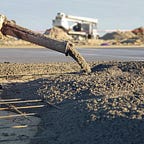Why is the Concrete Slump Test Being Used to Determine Quality?
The procedure used to determine a slump was first introduced in the early 1920's. The original ASTM method was used to assess the overall quality of concrete. A higher slump meant it was more flowable, or workable. This workability had a direct correlation to how much water was added to the mix. Workability equaled more water. Therefore a higher slump meant a higher water-cement ratio. This would ultimately lead to lower strengths.
Decades ago, this philosophy was probably true. However, with innovation and advances in mix designs, now this idea is fundamentally flawed. Cementitious materials and aggregates can have significant impacts on workability, but at the same time not disrupting the water-cement ratio. After all, water-cement ratio is what ultimately determines strength, workability does not. Admixtures such as mid-range water reducers and superplasticizers have the ability to reduce water-cement ratio while adding workability (higher slump). We end up with high strength, quality concrete with a higher slump.
Rejected trucks for concrete slump
If you've been in the concrete business long enough you've run into a situation where a slump test reveals a slump 1/4" or more over what is mandated by the EOR. What are some possible outcomes? Ultimately the truck could be rejected by the inspector. This happens quite often actually. Or he reports the violation and it shows up in a lab report that will raise questions about about overall strength. In reality you could be out of spec on your slump, but still be within the allowable range on water-cement ratio. As long as you are maintaining the ratio and only adding withheld water, slump should not be an issue. As Bruce Suprenant details in this article in Construction Pros, the best way to determine strength and durability is to test the air content as well as compressive strength of the hardened concrete, not a slump test.
Rejecting a truck on this basis alone is not the right decision and leads to cost overrun and delayed schedules.
There is still a reason to test concrete for slump
As Bruce also notes, when placing concrete where a specified flatness is required, consistency of a slump is very important. When the finishing process is underway, trucks that may have delivered concrete with varying slumps can cause difficulty for finishers. Also, in structural columns and beams it is important to have a consistent slump for proper consolidation in order to to avoid honeycombs. The slump consistency is important in terms of the relationship between the concrete supplier and contractor, not the engineer and their specifications.
Bottom line on concrete slump test
When will the industry start to transition away from these specifications? They seem antiquated and in need of adjustment. There are several trade organizations that have been pushing for years to move to a more performance based specification. Let's continue to push in this direction. The current rules are causing delays during pours and forcing contractors to reject trucks that in reality may have perfectly fine concrete.
Feel free to leave a comment below to discuss.
While you're here join the community page to start a discussion or leave a post on our favorite building material...Concrete. Make sure to register. This is a brand new platform to discuss all things concrete.
Brian Carson
